Tamil Nadu is a southern state of India which is a land of cultural and religious heritage. Known to be one of the oldest civilizations in the world, the people of Tamil Nadu belong to the prestigious Dravidian Family. Tamil Nadu is a plethora of history and beauty. It is a blend of both the ancient the modern history, which makes it a beautiful destination. Tamilians have perfected the art of spinning, weaving and chiseling over the years and their brilliance is reflected in different art subjects like bronzes, sculptor works, carvings, etc. Magnificent temples represent Tamil architecture with lofty ‘gopurams’ and statues of goddesses engraved all over the edifice. Many well-known temples such as Meenakshi Amman Temple and Breehadeeshwara Temple are located here which displays a grand vista of ancient Hindu mythological diversity and Tamil heritage.
Costume of Tamil Nadu
Tamil Nadu is hot and humid regarding climate. The clothing is suitable to the environment for the comfort of living and changed according to the occasions.
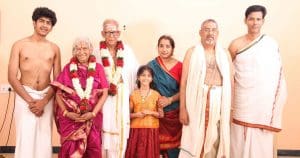
https://scroll.in/article/851627/what-the-relationship-between-the-palghat-iyers-and-malayalis-tell-us-about-kerala-and-tamils
There are two main Tamilian Communities – “Iyer” and “Iyengar” worshippers of Lord ‘Shiva’ & Lord ‘Vishnu’ respectively. Based on these communities, their costume also differs.
Costume of men:
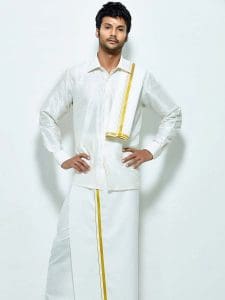
https://scroll.in/article/851627/what-the-relationship-between-the-palghat-iyers-and-malayalis-tell-us-about-kerala-and-tamils
Tamil men wear a dhoti known as Vesti, Panchkattu or Panchgacchhe. Pleats in the back known as gochi and front as Kosavam. Right side long, pleated and tucked in front.
Godakattu is the cloth wrapped around the waist and two ends are tied in front without formation of pleat. Paibatta is an angavastra used to cover upper body & tied at waist. They wear ‘Janoi’ a sacred thread on the left shoulder across the right hip and apply Naman with Vibhuti on forehead.
Costume of women:

https://www.storypick.com/south-indian-friend-experiences/
Tamil women wear ‘Madisar‘ which is 9 yards long sari with blouse known as ‘Ravika’. It is made of silk with zari border and has length till waist & elbow length sleeves.
Young girls wear long skirt called ‘Langa’ & half sari called ‘Oni’. Little girls wear skirt blouse called ‘Pattu Pavdai’.
Draping of Madisar: Iyer

https://www.utsavpedia.com/attires/intricate-styles-of-iyers-and-iyengers/
The sari is tied in the left then taken behind & drawn in the front from right side. Then pallu is taken on the right shoulder from right to left, and the length of the pallu is long till knee. The remaining sari is then pleated and tucked in front pleats known as ‘Kosava’. Pleats are then divided into half & tucked at the back under the pallu called ‘Paita’. The sari is worn above the ankle and the pallu is drawn from left armpit to the front, spread in the front and tucked at the back. End of the pallu is known as ‘talappu’.
Iyengar women drape sari in a different way. The only difference is the pallu is taken on the left shoulder from left to right. Then it is drawn from right armpit to the front, spread in the front and tucked at the back.
Ornaments:
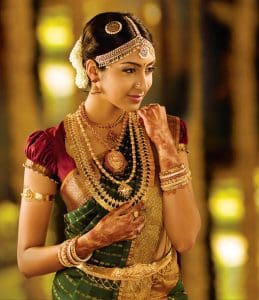
- Head
1. Talaisanam- 3 chains & pendant to cover the centre partition and forehead.
2. Chandra prabha & – Moon shaped brooch worn on the left side of the head.
3. Surya prabha- Sun shaped circular brooch worn on the right side of the head.
4. Rakodi- Multi colour circular brooch for back side of the head before starting plait. - Ear
1. Jhumkis- Bell shaped jhumkas with floral studs.
2. Vishala mungu- Small earing worn on top of the ear. - Nose
1. Muku buttu- a nose ring worn on the right side.
2. Bullaki- Worn on the centre of the nose. - Neck
1. Malai- Thin necklace with delicate engraving.
2. Kasumalai- Overlapping coin necklace. - Arms
Vanki- Curved armlet worn on the upper arm. - Waist
Vaddanam- Waistband of solid gold. - Ankle
1. Golusu- Thick silver payal carved with thick bells at the lower end.
2. Metti- Toe ring with 2-3 twist. - Thali
-
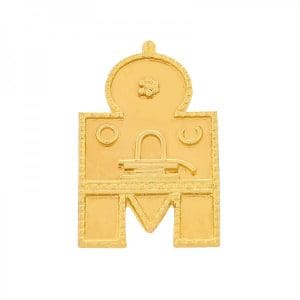
https://www.rajjewels.com/22-k-yellow-gold-2-leg-lingam-thali-pendant-gthp-2lltt3-0.html
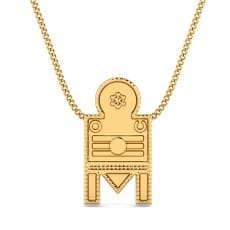
https://www.sktm.in/gold/thirumangalyam-c88c111.html
- Mangalayum worn in the neck with gold pendant as a Marriage symbol. As per the community symbols are engraved on it, ‘Shivling’ for Iyer & ‘Naman’ for Iyengar.
Textiles of Tamil Nadu
Kanchipuram sari
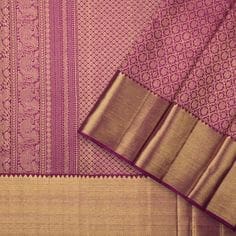
https://www.pinterest.com/pin/576179346080126796/
Kanjivaram saris were manufactured as gifts to Goddess. Hence, initially they were smaller in width and made of pure gold. The sari is sold depending upon its weight, which is directly related to the amount of silk & gold used. Normal weight of the sari is 40 gms/ sq. yard whereas, Kanjivaram sari weighs 50-6- gms/sq. yard. Kanchipuram sari got its Geographical Indication (GI) by the Government of India in 2005.
History of Kanchipuram sari
According to Hindu Mythology, Kanchi silk weavers are the descendants of sage Markanda; the master weaver of Gods who is supposed to have woven tissue from Lotus fibre. Also cotton is considered to be the favourite fabric of Lord Shiva, silk was preferred by Lord Vishnu. It became famous as it was patronized by Krishna Dev Raya.
High quality silk and real or artificial jari is used as fibers. Originally, border of the sari was 10-15” now-a-days it is made in 5-12”; Pallu is 1 to 1 ½ yard. Both decorated with zari. Typical motifs used in these saris are the sun, moon, chariots, swans, peacocks, parrots, lions, coins, mangoes and leaves. These saris are usually made in dark colours such as red, saffron, orange, brown, green, maroon, peacock blue and dark pink with bright contrasting borders. Body of the sari can be plain, checked or striped. They have buttis at regular intervals. Apart from regular border, it has an additional temple border which is must for the saris offered to the Goddess.
Manufacturing Technique- Simple pit loom with Dobby attachment is used. Extra warp yarns are used to make designs. To weave a Kanchipuram sari three shuttles are used. While the weaver works on the right side, his aide works on the left side shuttle. The border colour and design are usually quite different from the body. If the pallu has to be woven in a different shade, it is first separately woven and then delicately joined to the Sari. The part where the body meets the pallu is often denoted by a zigzag line. In a Kanchipuram Silk Sari, body and border are woven separately and then interlocked together. The joint is woven so strongly that even if the saris tears, the border will not detach. That differentiates the kanchivaram silk saris from the others. Intricacy of work, quality and craftsmanship have helped Kanchipuram sari earn its name.
Sungadi sari
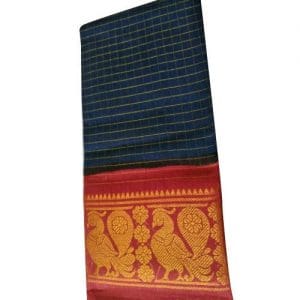
https://www.indiamart.com/proddetail/madurai-sungudi-cotton-saree-19827505933.html
Madurai produces very beautiful block printed sarees called Sungundi sarees. Good quality cotton is used in this sari. Colour Combinations used are Navy blue- Turquoise blue, navy blue- magenta, mustard- golden yellow, brown- mustard border and pallu is in contrast to the body colour. It has 3” border & 10-12” pallu.
Manufacturing Technique- The fabric is first dyed in light colour, then the diagonal rows of squares or diamonds printed with wax dipped blocks of squares.
Coimbatori sari
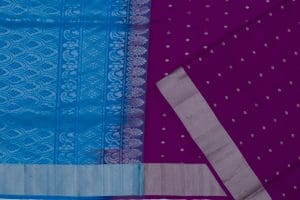
https://www.kankatala.com/coimbatore-silk-butta-purple-saree.html
Fibers used are cotton or silk, especially mulberry silk and sometimes zari is also used. Motifs used in these saris are swans, peacocks, parrots, lions, coins, mangoes and leaves. But quality of silk is not so high thus the price low.
Salem sari

https://www.youtube.com/watch?v=mhBsoXqF6m8
Fiber used is art silk. Its design is similar to Kanchipuram, contrast pallu and border but the border is thicker than the body.
Kalakshetra and Adiyar saris
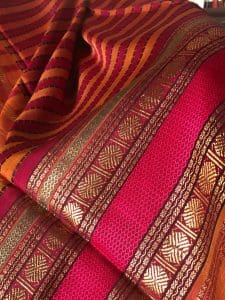
https://thevoiceoffashion.com/fabric-of-india/the-south-india-edit/the-kalakshetra-sari-as-a-cultural-destination–2813
The saris were prepared in Kalakshetra to be used for Bharatnatyam dance form. This sari was promoted by Bharatnatyam dance maestro Rukmini Devi Arundale. The ‘Kalamkari Centre’ was set up at Kalakshetra by her to revitalise the ancient Indian craft of textile printing.
Border and pallu of the sari are contrast. The pallu has vertical stripes whereas, border has geometrical, floral or temple design. The traditional motifs are Rudraksh, vanki, neli, diamond, star, salangai or manga butta. Adiyar sari’s weft yarns are tied-n-dyed in various colours is its main feature.
Kovai Kora cotton sari
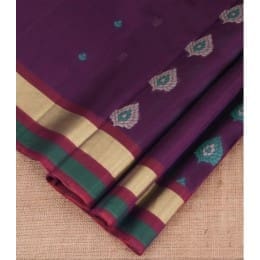
https://www.shoppingkart24.com/Kovai%20Kora%20Cotton%20Sarees%20%E2%80%83
Kovai Kora cotton is a type of sari made in the Coimbatore region in Tamil Nadu, India. It has been recognized as a Geographical indication by the Government of India in 2014-15. Kovai Kora cotton is made from a blend of silk and cotton. A superior quality cotton yarn is mixed with traditional silk to produce kora cotton. The kora cotton sari has a kora silk warp and a cotton weft yarn. The sari has a self-designed jacquard all over. The saris have bright colored border designs with occasional use of shining zari. The required designs are weaved using the loom using combinations of colored cotton and silk threads and the borders are added later.
Koorainadu and Kodambakkam saris

https://loomworld.in/koorainadu-silk-saree6.html
These saris are made in a cotton and silk mixture, often with a cotton body and a mixed silk and cotton border. The saris have broad borders and pallus, and the designs are geometric or floral. Some typical motifs are rudraaksh, flowers, bells, vanki rose-water pot and toe ring. A variety of checks are also used as designs.
Thirubuvanam sari
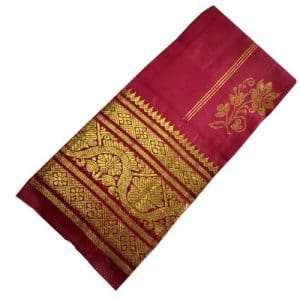
https://www.indiamart.com/proddetail/silk-sarees-13211860630.html
The speciality of Thirubuvanam Silk saree is that they are using filature silk for both wrap and weft, resulting in high Quality, Shine, Uniformity and luster. Elaborate end pieces woven separately and then woven together with the main body called as “Pitni” work. The fibers used are best silk yarn and pure zari. The weight of the sarees is between 450 gm to 1250 gm. In any type of sari the silk alone weights 400 gm and the balance is that of zari. Motifs used are Mango, Kalasam, Temple, Rudraksh, Diamond, Neli & vanki. The colours used are parrot green, coffee brown, golden yellow. They have contrast borders.
Chettinad Saris

https://www.indiamart.com/proddetail/chettinad-cotton-sarees-18099854262.html
Chettinad cotton saris or otherwise known as the Kandaangi saris are the signature pieces crafted by the Devanga Chettiyars of Tamil Nadu. Popular for their ability to stay cool and absorb sweat during hot and humid temperatures, these hand-woven saris are thick and not translucent. These are mostly woven out of cotton and have bold checks in vivid colours. These saris have huge contrasting borders in appealing colour combinations. The beautiful iridescent effect is achieved by using two different colour yarns in warp and weft.
Thanjavur and Kumbakonam Silks
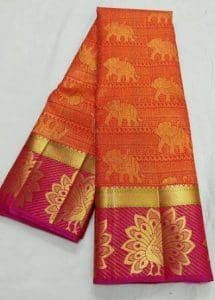
https://www.exportersindia.com/srimathi-textile/silk-sarees-3515522.htm
Thanjavur is another silk center, which specialises in the use of Zari and brocade work. These saris are heavy and opulent. Thanjavur and Kumbakonam create saris similar to Kanchipuram but the Mundhi or end pieces are finished differently. Using a technique called “Porai” the weavers pull the warp threads, at the join of two colours, into loops at the back and then cut it close. Motifs used are peacocks & elephants.
Mysore Crepe sari
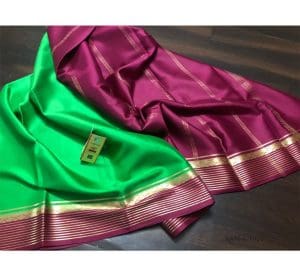
https://www.graameen.in/mysore-crepe-silk-saree-ram-s-1027.html
Highly twisted yarns of Silk are used, therefore fabric has lively feel. Style of the saris is contrast border & pallu. Border has narrow or wide zari design whereas; pallu has thin woven zari stripes.
Kalamkari sari

https://gocoop.com/products/brick-red-hand-block-print-kalamkari-saree
Kalamkari in Tamil Nadu is done with blocks and in Andhra Pradesh with brush. In Tamil Nadu it is made in Masulipatanam. Fiber used is cotton & all natural dyes such as henna, turmeric, alum (mordant), indigo and jaggery are used. Designs are floral with painted shapes, stories of Ramayan & Mahabharat, Tree of Life motif, and auspicious symbols. Technique used is Block printing followed by hand painting with kalam.
Cow dung & cow milk are used for soaking the fabric overnight to make them soft and gives it a base cream colour. Originally the motifs were also drawn with kalam and then hand painted with black outline.
Monukukkukkual saris
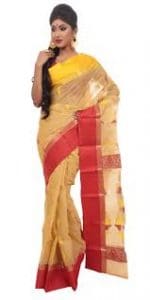
https://www.parinita.co.in/products/ganga-jamuna-tussar
Both borders are of different colours called as Ganga Jamuna border saris. They are similar in design and colour to the kanchipuram.
Chinnalapatti silk cotton saris
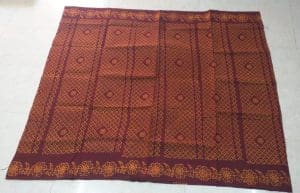
https://nativethings.in/product/chinnalapatti-hand-wax-batik-print-sungudi-cotton-saree/
The lustrous and finely tied and dyed silk cotton saris woven like ikats, appeal to a lot of working women. Chinnalampatti weavers have mastered the art of weaving “Kora” silk in warp and mercerized cotton in weft. It takes about two days to weave one sari, and these saris are inspired by the design and the technique of Pochampally ikats.
Kumbkonam sari

https://www.taneira.com/ta/product/sa-silk-kumbakonam-extra-weft-blue/SSSKKXWSLDXBSA28
Pure silk sari with extra weft yarns. It has a border on sleeves and hem along with butties on the body.
Korvai Dhotis
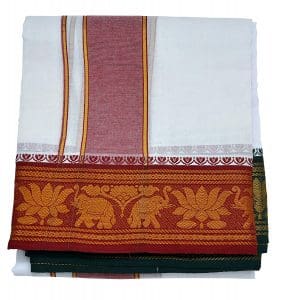
https://www.amazon.in/JISB-White-Cotton-Dhoti-Angavastram/dp/B07MJJTLXG
Korvai dhotis are made of cotton and silks. The method followed for both the fabric is similar. The two side shuttles carry colours for the border which include the same material and colours as the border warp. The middle shuttle carries the material and colour of the body of the dhoti or sari. The borders are woven with a non-continuous weft and interlocked together, creating firm, colour borders. The method of weaving involves the thread knotted with the weft of the body and positioned on the woven section.
Handkerchief
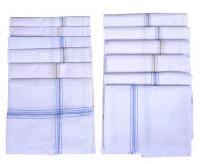
https://www.indianyellowpages.com/coimbatore/gravity-clothing-3028686/
Three to four handkerchiefs are made in one loom width. The warp threading is done by missing a dent between each set of yarns used for individual handkerchiefs. These handkerchiefs are made in Trichi.
Tribes of Tamilnadu
According to the Tamil Nadu forest department website, 6 tribal communities, Toda, Kota, Kurumbas, Irulur, Paniyan and Kattunayakan, have been identified as Primitive Tribal communities. Interestingly all the six tribes are natives to the Nilgiris.
https://www.thehindu.com/society/despite-being-educated-these-kattunayakan-families-are-living-in-poverty/article25235448.ece
The members of this community are short, have black skin, and have protruding foreheads. Hunting and collecting forest produce are the two main means of living for the tribe. They rarely mix with other tribes and still follow black magic and sorcery. They speak a language which is a mixture of Dravidian languages. Kattunayakans are known for their expertise in honey collection.

https://www.flickr.com/photos/92568888@N06/41233808051
The Paniya have historically worked as agricultural labourers. The Paniyas have only a crude idea of religion. Their major deity, is called ‘Kali’ and they also worship banyan tree. The Paniya speak the Paniya language, which belongs to the Dravidian family.

https://www.mindenpictures.com/search/preview/irula-tribe-member-and-professional-snake-catcher-for-venom-extraction-india/0_00423373.html
Irulas are engaged in collection of minor forest products. Some of them are also engaged in looking after the herds of cattle belonging to others. They speak Irula, which belongs to the Dravidian family. Irulas are specialists in traditional herbal medicine and healing practices. Traditionally, the main occupation of the Irulas has been snake and rat catching.
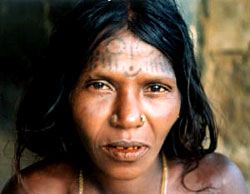
http://www.oneearthfoundation.in/the-kurumbas-their-paintings/
The traditional occupation of the Kurumbas is food gathering, like collection of honey and forests produce. Kurumbas are known to possess keen eyesight, gained possibly from constant watching of the honey bee to the hives. They still use bow and arrow for occasional hunting.

http://www.oneearthfoundation.in/the-kurumbas-their-paintings/
Kurumbas are known for their painting and black magic.

https://www.outlookindia.com/photos/topic/kota-tribes/105715
Kotas claim to be blacksmiths by profession and making agriculture equipment and weapons for war. Kotas have their own unique language that belongs to the Dravidian language family. Kotas worship fire, moon and nature and perform poojas in front of the peepal tree.
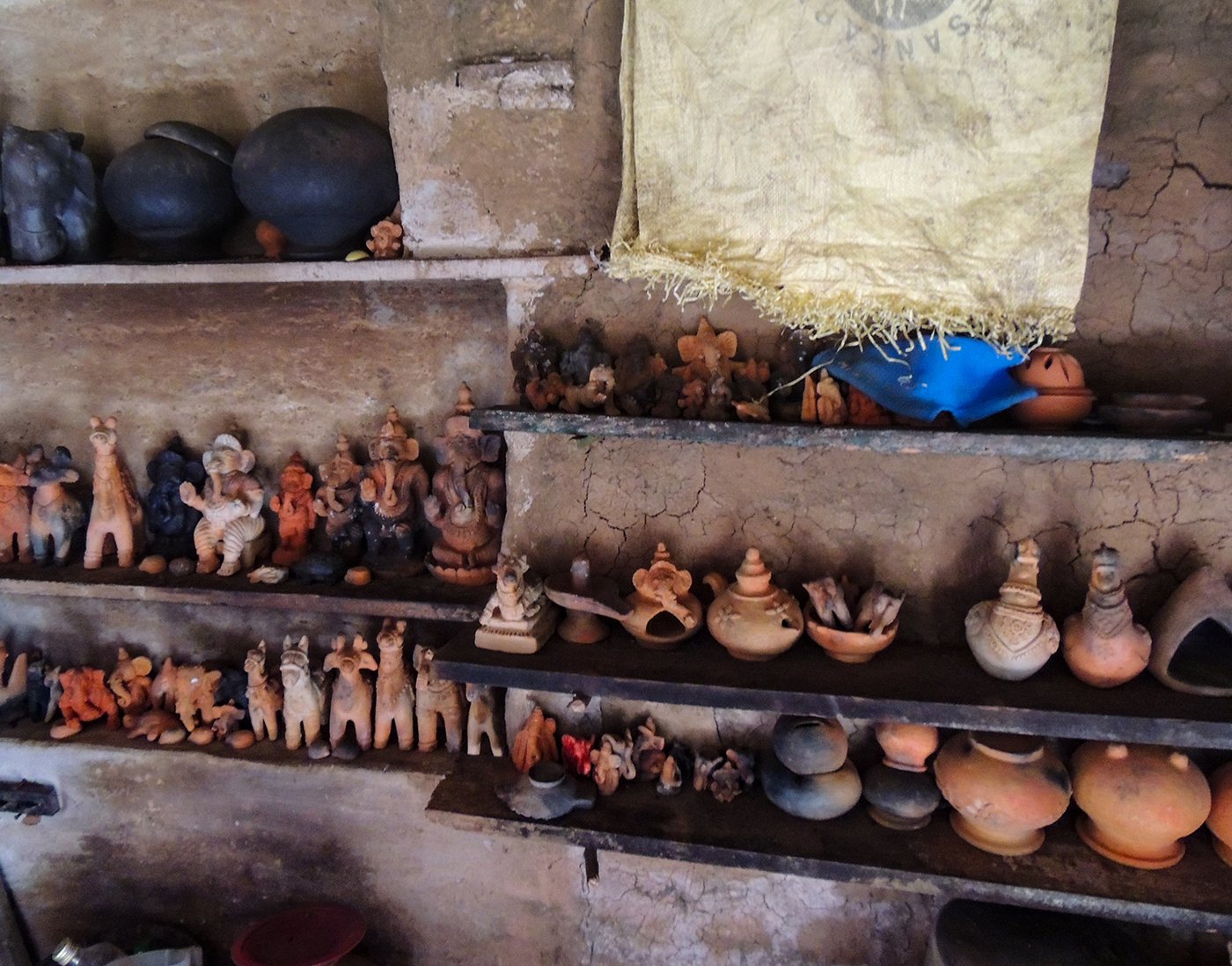
https://ruralindiaonline.org/articles/women-at-the-wheel-in-the-nilgiris/
Kotas are known for their pottery and carpentry.
Toda Embroidery
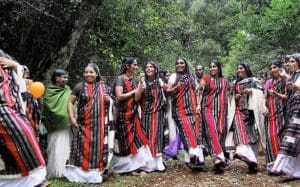
https://vicquotes.blogspot.com/2019/04/life-quotes-in-tamil-movies-with-images.html
The Toda pastorals of Nilgiris are known for their embroidery. The embroidery, which has a fine finish, appears like a woven cloth but is made with use of red and black threads with a white cotton cloth background. Both sides of the embroidered fabric are usable and the Toda people are proud of this heritage. The embroidery is done on the shawls by the women folk. The shawl, called poothkuli, has red and black bands that end at intervals of six inches that gives an embossed while the embroidery is done between the gaps in red and black .Geometric pattern is achieved by counting the warp and weft in the cloth used for embroidery. Both men and women adorn themselves with the embroidered cloaks and shawls.

https://gaatha.com/toda-embroidery/
The local terms used to describe the embroidery work is ‘kuty’ meaning “stitching” and ‘kutyvoy’ meaning the embroidered piece. The materials used in this work are roughly woven white cloth, woolen black and red threads with use occasionally of blue threads and manufactured needles. The designs developed relate to nature and the daily cycle of life.
The fabric used is coarse bleached half white cotton cloth with bands; the woven bands on the fabric consist of two bands, one in red and one band in black, spaced at six inches. Embroidery is limited to the space within the bands and is done by using a single stitch darning needle. It is not done within an embroidery frame but is done by counting the warp and weft on the fabric which has uniform structure by the reverse stitch method. To bring out a rich texture in the embroidered fabric, during the process of needle stitching, a small amount of tuft is deliberately allowed to bulge.
Thoranams/Appliqué Embroidery

https://www.amazon.co.uk/Indian-Traditional-Embroidered-Decorations-Decorative/dp/B07PMRZ1HT
Very few craftsmen are practicing this craft today in Madurai, Tamil Nadu. Practitioners belong to Pilamar caste and are a close-knit community. The main product of the decorated temple chariot is the ther seelai. Appliqué hangings are found on temple chariots and were used mainly as thoranams/lintel pieces during festival processions. When they are tubular in shape they are thombais and they look like colourful pillars as they hang down the sides of the chariot. They are mainly made of cotton or felt in rich, bright red, yellow, white, black and cobalt-blue. The sacred images used in these hangings are of Gods and Godesses like Durga, Ganesh, Kartikeya and Shiva.
Art & Craft of Tamil Nadu
The exquisite arts and crafts of Tamil Nadu in the chronicles of Pliny, Kautilya and other scholars who marvel at the states fine silk, soft muslin, ornate ivory work and precious stones like diamonds, rubies, pearls and tortoise shell.
Paintings
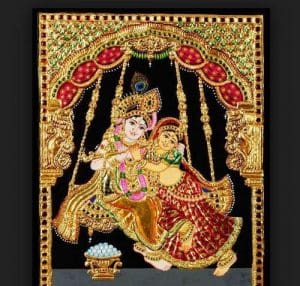
https://www.indiamart.com/proddetail/radha-krishna-tanjore-painting-15407855133.html
The Tanjore paintings are a hallmark of India’s rich cultural legacy. It has been recognized as a Geographical indication by the Government of India in 2007-08. Painted in vibrant shades embellished in colorful semi-precious stones, pearls, glass pieces and gold, they form some of the world’s masterpieces done on surfaces of wood, mica or ivory. The paintings also adorn the ornate pillars, elaborately decorated canopies and garlands of ropes and chandeliers. Common subjects were Gods and Goddesses, episodes from Hindu mythology; Fairs, ceremonies, processions and festivals; Castes, their occupations and dresses; Indian Flora and Fauna, etc.
A wooden board is prepared. The paintings are done on a separate unbleached cloth and treated with a mixture of glue and chalk powder. Finally the drawing is traced on the board, followed by elaborate and exquisite embellishments and painted with an amalgam of chalk powder and gum Arabica to produce three dimensional stylized shading effects that is truly a sight to behold.
Stone Icon Carving

https://www.flickr.com/photos/asienman/9217495361
Swamimalai, Ramanathapuram, Trunelveli, Tiruchirapalli, Thanjavur and Kanyakumari districts have highly skilled artists making stone icons are known as Sthapathis. Stone icons are also made in Gopichettipalayam and Satyamangalam in Salem district and Tiruvannamalai. Miniature carvings of humans, birds , and reptiles are done at Madayur village. They use traditional methods of stone carving as approved in the Shilpa Shastra. They are polished by hand to give the figures a good glaze and glare. Rubbing with wax is also done to give the figures a lustrous appearance. One of the specialties of stone carving at Tamil Nadu is the illustration of animal and bird life.
Doll Making
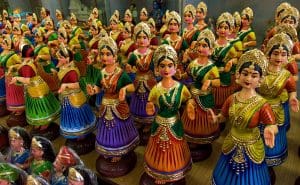
https://theculturetrip.com/asia/india/articles/9-reasons-why-thanjavur-is-called-the-cradle-of-arts-in-tamil-nadu/
A toy’s appeal lies in the form and shape, the beauty of line, the color and detail, the charm of miniaturization, and the humor of caricature. Many do things we can’t do in real life, thereby keeping us in touch with fantasy. Dolls, Toys and games had always fascinated children. Ancient children played with marbles, dice and stuffed dolls. Historically toys and games were hand made at home using tin, wood and cloth. Dolls, toys and games reflect the inventor’s imagination of the culture and time of creation. Some board games, chess and dolls have been popular for generations. Handcrafted toys and games are made of mud & clay, wood, coir, cane & bamboo, wire & metal and stuffed soft toys made of cloth, cotton and wool. They create an excellent employment opportunity for the rural artians globally.
Toy-making

http://www.dsource.in/resource/wooden-toy-making-kanyakumari-tamilnadu/introduction
Toy-making is a widely practised craft in Pondicherry where different materials are used in their production. Homemade toys in this region are made of leaves, fruit skin like pomegranate skin, twigs, paper and wire. Vahanas or vehicles made of wood on wheels are usually pull-along toys for the child or be used as walkers for toddlers.
Wood Carving
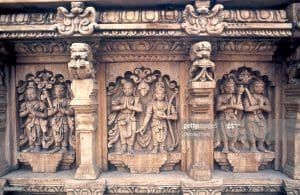
https://www.gettyimages.co.uk/detail/photo/wooden-carving-statues-in-old-temple-chariot-at-royalty-free-image/520906098
The finest wooden carving are in the temples of Tamil Nadu and the piece-de-resistance are the processional chariots for the deities, these include numerous mounts/ vahanas and small pillared shrines/ rathams for the deities. The temple woodcarvers and carpenters belong to the Kammaalar caste. Patronage of the traditional crafts demanding fine detailing has petered down, so the number of craftsmen practicing the art has decreased.
Kora grass mats

https://www.exportersindia.com/arafa-industries/kora-grass-mat-vellore-india-1447690.htm
Mats made with kora / sedge grass are extremely delicate. Kora grass is found in abundance along the banks of the rivers and in marshy areas in Tamil Nadu and Kerala. The process of creating the mat is painstaking and time consuming. The grass which grows to a height of 3-4 feet is green in colour. The grass is harvested in the months of September/ October and February/March and is cut very finely while it is still green. The outer part of the stem is used for weaving while the inside of the stem is removed with a sharp-edged knife. The strips of grass are then dried in the hot sun and care is taken not to expose the grass to humidity, as they tend to turn black with the exposure. As the dried grass strips turn a yellowish green colour they are boiled in a pot of water and then dried again. The dried grass is made up into bundles and then soaked in running water so that the grass remains just below the surface of the water for three to seven days which causes the grass to swell up to three times its original size. After it is then dried again in the sun the slow process of weaving commences on a floor loom. Once the weaving is complete, the mat is dried in the sun for a short while after which it is polished.
Tamil Culture
People who live in the state understand the ethnicity of their culture and how it marks their identity in the world. They are very adherent towards their rituals and traditions. Tamil culture is rooted in the arts and ways of life of Tamils in India, Sri Lanka, Malaysia, Singapore and across the globe.
Tamil culture is expressed in language, literature, music, dance, theatre, folk arts, painting, sculpture, architecture, sports, media, comedy, cuisine, costumes, celebrations, philosophy, religions, traditions, rituals, organizations, science, and technology.
Music & Dance
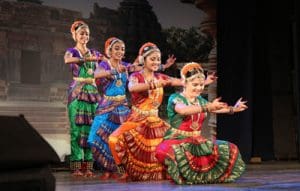
https://www.tourmyindia.com/states/tamilnadu/dances.html
The most important form of music was the Carnatic music which considered only for the elite who could understand the intricacy of music.
Bharatnatyam is the official dance form of Tamil Nadu, recognized all over India and the world. It’s a complicated dance form with subtle moves of body parts and expressions. Some other folk dances like Parai, Villuputtu Karakaatam, and Kuthu are also performed by local people including tribal people.
Art & Architecture
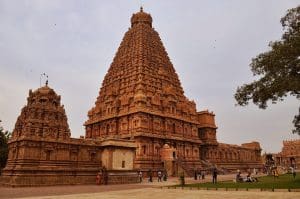
https://www.tripsavvy.com/top-tourist-places-in-tamil-nadu-1539725
Most traditional art are religious in some form and usually centres on Hinduism, although the religious element is often only a means to represent universal—and, occasionally, humanist—themes. The most important form of Tamil painting is Tanjore painting, which originated in Thanjavur in the 9th century. A style which is related in origin, but which exhibits significant differences in execution, is used for painting murals on temple walls; the most notable example are the murals on the Kutal Azhakar and Meenakshi temples of Madurai, the Brihadeeswarar temple of Tanjore.
Tamil sculpture ranges from elegant stone sculptures in temples, to bronze icons with exquisite details. Unlike most Western art, the material in Tamil sculpture does not influence the form taken by the sculpture; instead, the artist imposes vision of the form on the material. As a result, one often sees in stone sculptures flowing forms that are usually reserved for metal.
Tamil Cuisine
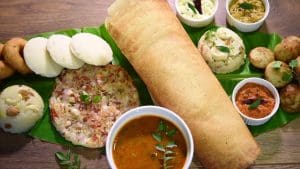
https://www.shutterstock.com/video/search/south-indian-upma
When we say South Indian Food the first thing comes in mind is Idli, Dosa, Sambhar, Vada, Upma and what not. Tamil Food is popular in both vegetarian and non-vegetarian contexts. Otherwise, rice, lentils, grains and vegetables from the main ingredients in Tamil Cuisine. Rice is the staple food of most Tamil people. It is generally used during lunch and sometimes dinner. Choru is served along with other food items such as sambar, poriyal, rasam, kootu and curd. For non-vegetarians, fish, mutton and venison are preferred. Some Tamilians follow the tradition of eating on Banana Leaf even today. After eating, the banana leaves are then used as a secondary food for cattle.
Official Tourism Website: http://www.tamilnadutourism.org/
References:
https://www.mapsofindia.com/tamilnadu/arts-and-crafts.html
https://www.holidify.com/pages/culture-of-tamil-nadu-124.html
http://www.craftandartisans.com/

Article written by- Ms. Sampada Girish Surve, B.Sc. in Textile & Apparel Design from SVT college of home science, Intern at Textile Value Chain

